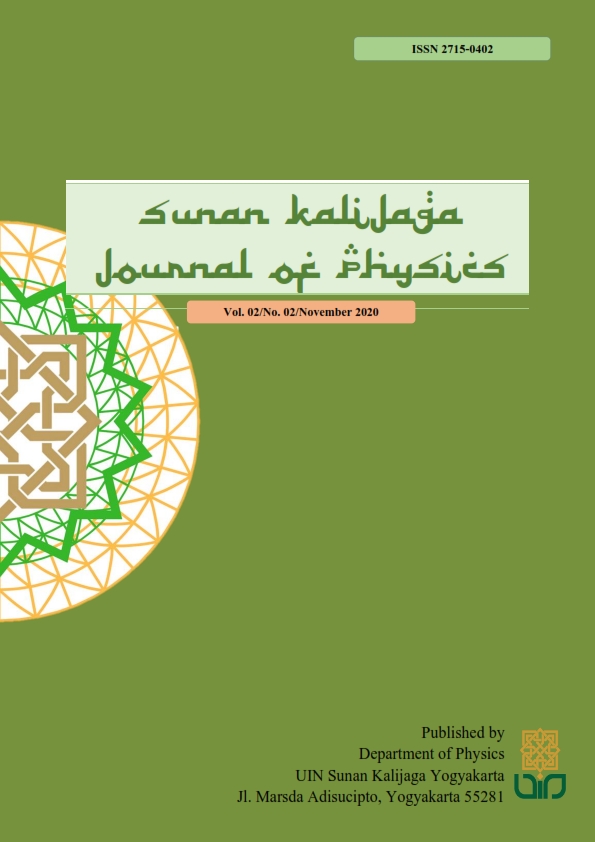Pemodelan Struktur Dan Mekanisme Interaksi Neuron-Astrocyte Dalam Proses Transfer Informasi Dengan Simulator Brian2
DOI:
https://doi.org/10.14421/physics.v2i2.2293Keywords:
Astrocyte, Gap-Junction Channels, Gliotransmitter, Integrated-and-Fire, Li-Rinzel, Neuron, Simulator Brian2Abstract
The modeling of neuron-astrocyte interactions in neural networks has been successfully carried out using the Brian2 simulator. The neuron model used is Integrate and Fire, while the astrocyte network model is defined by the Li-Rinzel equation which involves the IP3Rs (q) activation fraction which affects the value of calcium concentration in astrocytes. Interaction modeling between neuron networks and astrocytes involves four types of connections, namely connections between neurons connected by synapses, connections between astrocytes in the form of gap-junction channels (GJCs), synaptic connections to astrocytes and astrocyte connections to synapses. The synaptic connection to the astrocytes is made to trigger the activation of the astrocytes by releasing the neurotransmitter. The astrocyte connection to the synapses is established as a route for the production of the gliotransmitter. The modeling results show that the information transfer mechanism carried out by neurons is in the form of electric current wave propagation, while the information transfer carried out by astrocytes is in the form of calcium wave propagation.References
Djuwita, Ita., dkk. 2013. Induksi Ekstrak Pegangan Secara in vitro terhadap Proliferasi dan Diferensiasi Sel-Sel Otak Besar Anak Tikus. Jurnal Veteriner, Vol.14 No.2 September 2013: 138-144.
Sofroniew, M.V., dan Vinters, H. V. 2010. Astrocytes: biology and pathology. Acta Neuropathol 119:7–35.
Nadkarni, S., dan Jung, P. 2003. Spontaneous Oscillation of Dressed Neurons : A New Mechanism for Epilepsy? Physical Review Letters. Vol.91 No.26: 1-4.
Wallach, G., Lallouette, J., Herzog, N., De Pitta, M., Jacob, E. B., Berry, H., dan Henein, Y. (2014). Glutamate Mediated Astrocytic Filtering of Neuronal Activity. PLOS Computational Biology (10), e1003964
Nadkarni, S., dan Jung, P. 2004. Dressed Neurons : Modelling Neural-Glia Interactions. Physical Biologi. 35-41.
Stimberg, M., Goodman, Dan F.M., Brette, R., De Pitta, M. 2017. Modeling Neuron-Glia Interactions with The Brian 2 Simulator. doi: https://doi.org/10.1101/198366
Fauzia, Syifa. 2019. Pemodelan Astrocyte Li-Rinzel Dengan Stimulasi Neurotransmitter Sinapsis. (Tugas Akhir), Prodi Fisika, UIN Sunan Kalijaga, Yogyakarta.
Burkitt, A.N. 2006. A Review of the Integrate-and-fire Neuron Model: I. Homogeneous Synaptic Input. Article in Biological Cybernetics. 20 March 2006
Gerstein, G.L. dan Mandelbrot, B. 1964. Random walk models for the spike activity of a single neuron. Biophys J. 4 :41–68
Tang, J., Luo, Jin-Ming, dan Ma, Jun. 2013. Information Transmission in a Neuron-Astrocyte Coupled Model. PLoS ONE 8(11): e80324
Bootman, M. D., Berridge, M. J., dan Roderick. H. L. 2002. Calcium Signalling: More Messengers, More Channels, More Complexity. Current Biology. Vol.12 20 Agustus 2002 : R563–R565
Goodenough, Daniel A. dan Paul, David L. 2009. Gap Junctions. Cold Spring Harb Perspect Biol. 1 : a002576
Tondas, Alexander Edo dan Yuniadi, Yoga. 2010. Role of Gap Junction in Atrial Fibrillation Pathophysiology. Jurnal Kardiologi Indonesia. Vol.31 No.1 Januari-April 2010 : 48-57
Harada, K., Kamiya, T., dan Tsuboi, T. 2016. Gliotransmitter Release from Astrocytes: Functional, Developmental, and Pathological Implications in the Brain. Front. Neurosci. 9 : 499
Araque, A., Carmignoto, G., Haydon, P. G., Oliet, S. H. R., Robitaille, R., dan Volterra, A. 2014. Gliotransmitters Travel in Time and Space. Cell Press. Neuron 81, 19 Februari 2014
Brian Simulator Team. 2017. Brian 2 Documentation. Diakses 20 April 2020 dari https://media.readthedocs.org/pdf/brian2/stable/brian2.pdf.
Downloads
Published
How to Cite
Issue
Section
License
Copyright (c) 2021 Itsnainiyah Hafizhoh, Anis Yuniati

This work is licensed under a Creative Commons Attribution-ShareAlike 4.0 International License.







